| |
"I'm not religious in the sense that I think we have connections to heaven, but I do have full respect for the Sermon on the Mount – 'Do to others as you would have them do to you.'" |
| |
Director Roy Andersson, Interview, The Guardian, 9.2.2001 |
Ah, the Golden Rule... And yet Andersson's characters never seem to be on the receiving end of that particular tenet of wisdom, quite the opposite. It's not so much 'dog eat dog' as 'genetically engineered super-wolf eat desperate, weakling homunculi hordes'. But then Andersson was always on the side of the metaphorical little person even if his characters are on the portly side. So what is it with my recent exposure to northern European art and craft? First from Sweden; there're the two Wallanders from Henning Mankell and the sublime Let The Right One In (I've not seen the remake) from Tomas Alfredson. Having devoured Stieg Larssen's 'Girl' trilogy in print and screen with hardly a pause for breath (Go, Salander!), then along comes the sublime Danish TV series 'Forbrydelsen' featuring my current favourite detective, Sarah Lund (the wonderful Sofie Gråbøl). Forget the jumpers, just look at those eyes, indicators of a beautifully judged performance that made me care more than I have for a long time. Now I go back to Sweden with Roy Andersson's 2000 film Songs From The Second Floor. While Slarek's review for Andersson's follow up You, The Living essentially introduced me to the great Swede's work, a few moments of basic research has led me to his very recognisable and sympathetic (to me at least) worldview. Here's a film-maker whose presentation of the absurd, sense of humour, surrealism and despair are all rolled into one giant layer cake of multi-meaning and endless interpretation. As Mr. Whedon once said about his own layered work, "...bring your own subtext." I forgot to mention another crucial facet of the Andersson effect – magic.
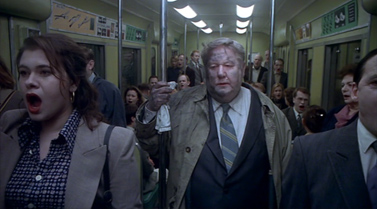
Left leaning political readings are inevitable (please see Slarek's review of You, The Living to get a revealing insight into why this very site was brought into existence). The film's humour is rarely laugh-out-loud guffaw inducing but there is a captivating spell that Andersson weaves that is undeniably original (that's good enough to stop this sentence in its tracks). His work is strangely rewarding and in a bizarre fashion true to the very core of what it is to be human. Pretentious? I don't think so. It's not for nothing that Andersson has been described as a 'slapstick Ingmar Bergman'. Smiles Of A Summer Night At The Opera, anyone? And yet, I couldn't get Chris Morris' extraordinary TV series Jam out of my head. It shared with Songs a bleak, darkly comic edge that was recognisable, critical and downright bizarre. Both were mesmeric and being in the right, receptive mood, you could float away with Andersson's imagination but no guarantees where you'd end up. In a Jesus strewn junkyard assailed by personified guilt, no doubt... But I'm getting ahead of myself.
As with his latest film You, The Living, Songs is essentially a series of beautifully designed and directed – and loosely related – short scenes throughout which the camera moves just the once. That's not remarkable or noteworthy on its own because it's neither here nor there if the camera moves or not but what this unique style does is coach an eye-roving interaction from an audience. At the very basic level, you're hunting around the frame (if there are many characters inside the box) to find the person who's actually speaking. In this sense, you're playing catch up but this is not to the detriment of your viewing pleasure. There's no one specific narrative (or rather there are several with recurring characters but none surfaces as the single spine or 'star' of the piece). The vignettes' effect is one of a gentle, insistent spinning web slowly cocooning you in a worldview that is simultaneously wry and heartbreaking, surreal and caustic and above all readily accessible. It's an odd word to use in any review; accessible. It implies that certain film-makers deliberately go out of their way to make their films so esoteric as to alienate certain people. Surely not! Do film-makers do that? For shame... The cinematic playground is vast and there's room for both The Fox And The Hound and Un Chien Andalou. Hell, Joss Whedon scared off rational souls (like myself) who could never have initially appreciated the worth of anything called "Buffy..." – and worse – "...the Vampire Slayer". More fool us. But to make cinema to reward and challenge your audience and not have them slurping sugared water while being deadened by profundo bass crunching spectacle, is a noble pursuit however lofty that sounds.
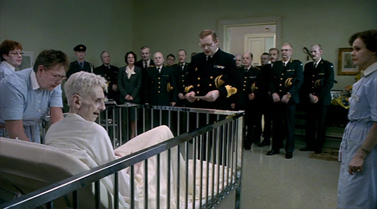
Andersson cites Peruvian poet César Vallejo's work as a major influence running through Songs and indeed, the movie starts with a rather wonderful quotation from a man hugely regarded in his field despite only publishing three volumes of verse (let's mention he wrote lots of other pieces outside of poetry). "Beloved be the ones who sit down..." I have to state a personal preference for what's engraved under his statue in the Peruvian capital, Lima. "There is, brothers, much to do..." which is about as sublime a line about human society as you're going to get. And Songs takes up the left wing mantle having sly and appropriate digs at capitalism (or rather how such a system strains and stretches human beings into shapes into which they were not comfortable becoming). The very first scene underlies this with visual aplomb. The 'boss' is invisible under a sun-bed (why? Mainly because most 'bosses' are invisible, the idea of capitalist superiority is faceless and therein lies its power. Its face is whatever you don't want it to be). The lounging boss's minion, Pelle, is forced to listen to this disembodied voice (apart from the feet) uttering, in his view, truisms about the worker/boss relationship. The flippancy in which he couches a future for 'us' and 'them' is then ironically scored by a jaunty and uplifting main title that is the rather terrific work of a certain Benny Andersson (no relation). If this name is familiar to those of a certain age it is because it is the Benny Andersson, ex-ABBA singer/songwriter. His work on Songs (alas only a main and end title) is sublime. There is an operatic accompaniment to the scene in a tube train (talk about mesmeric) and I can't confirm this as Andersson, (B.)'s work but its effect is still utterly magical.
Being an assembly of approximately 46 different vignettes, you'd think there'd be little to say about the editing but this is a misleading assumption. There is a transcendent example of a masterful cut at approximately 15 minutes and 40 seconds in. The underground train interior and the operatic singing of the passengers cuts to the inside of a caféteria. Not only is the singing held over by having the café patrons and staff continue their tube counterparts' performances but the perspective lines of both structures in both shots are mirrored almost exactly. Don't think these things are accidents. One place of pressure and discomfort – a crowded tube – is replaced by the place of supposed leisure and relaxation – a caféteria – and both are small boxes in which Pelle is at the centre of a great deal of angst. Editing (and its value, success or failure) is based on serving the overall film. Fast cutting imposed on Andersson's style of film-making would be like being shown fifty works of painted art in as many seconds and being expected to extract meaning from the experience. The irony here is that while the introduction of HD has significantly slowed down the fashion for outrageously fast editing, what we have here is a DVD not a Blu-ray. Andersson's work, I suspect, will just increase in relevance and appreciation once the detail is set free to gambol and frolic on a larger canvas.
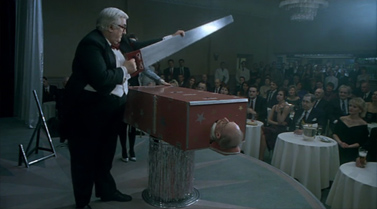
One last aspect to note; It is worth having a look at some of the extra features just to get an appreciation of the sheer amount of labour that goes into Andersson's assured frames. As he is in control of every facet and there is no digital tinkering, no matter how tempting, the craft on display is somehow more 'real' and the respect earned is more valued. This is no Luddite talking. CG has its place and I can be wowed with the rest of us as marvels of special digital effects create monstrous waves, cave trolls and alien worlds. But I'm also a big fan of the practical answer to creative questions. Andersson's answers are unique, heartfelt and in every cinematic sense of the word, magical.
Presented in anamorphic 16:9, the wonderfully composed images are pleasing with an evident softening belying their celluloid origins. The start of the transfer shows a surprising amount of negative or print dust. The dark spots in the first scene in a traditional post-production workflow would indicate dirt on the frames of the inter-positive or print. Let's be fair, I was looking hard for imperfections and with the director's commitment to 35mm film, it's not hard to pick up dust working solely in that medium. It wouldn't surprise me if Andersson's purity of film-making dismissed the obvious advantages of digital dust-busting – the removal of dirt by hand frame by frame in a digital context. There are dirty moments but none that pull you out of the web he's spinning. One suspects that the images presented on the DVD (in terms of colour and contrast) are very close to those captured on the negative. Do you go to this much trouble so someone with the application 'Color' can tweak certain aspects of this highly controlled frame in a mere thoughtless five minutes? I know, it's a romantic notion but with this level of directorial control, do you think there'd be any real picture work left to do in post? Major colour correction? Surely not.
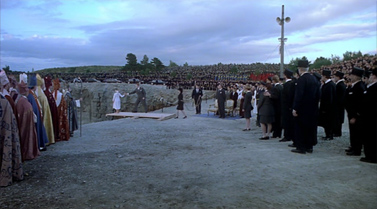
The Dolby Digital 2.0 soundtrack is clear and the surround effects subtle which is my way of saying the sound is there but it's essentially a stereo mix – all part of the spell you might say. There are English sub-titles but that's your lot.
Excerpts from Roy Andersson Films (15' 31")
- A Swedish Love Story
- Giliap
- Something Happened
- World Of Glory
- Songs From The Second Floor
While I question the inclusion of a clip from a film that serves as the DVD's main feature, I can't complain about the clip from World Of Glory, a 1991 short which went on to great acclaim. I have not seen the full 14 minutes but this clip is so irredeemably powerful due to performance, direction and design that it floors all the others. Now, you may say if you have seen the film, it's all in the subject matter. You may have a point. Having reviewed the behemoth Shoah a few years go (a French film-maker's epic investigation into the Holocaust) and thought hard on the incredulity I felt hearing the stories, here is the reality of it dramatised horrifically. A naked, screaming child on the ramp of a diesel lorry is all that stands between life and death. The lorry, full of naked Jews, is closed up and in a practical, almost mundane way, the exhaust pipe is attached to the door and the lorry drives off spewing noxious fumes into the lorry thereby murdering its terrified cargo. This was the forerunner of the gas chambers. The stillness of the participants and their simple witnessing of events make you want to scream at the screen in fury. There is no conventional intercut 'action' sequence I can imagine that would make this more terrifying (note, it's the witnesses that terrify me, the mundane nature of their compliance with this wicked act).
The other more conventionally shot and edited clips have their moments, no question, and encourage you to seek out Andersson's earlier work.
The Making of the Burnt Furniture Scene (11' 37") & The Making of the Magician Scene (2' 44")
These two extras reveal the extraordinary lengths that Andersson and his cast and crew go, to make his craft and art a richly textured reality. I'm not suggesting for a moment that one's level of appreciation goes up once the revelation of the effort that brought it to the screen is exposed but good grief – if fair blows the mind. In an odd way, Andersson's 'mise-en-scene' reminds me of the Hollywood Golden Age, when film-makers had absolute control in sound studios of what they shot and how they shot it. This is control par excellence and as such, it delivers a single artistic voice worth watching and listening to.
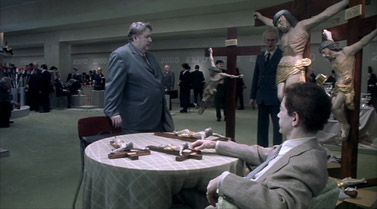
Obsessions From The Second Floor (26' 32")
This 4:3 letterboxed documentary seems to have been made by French film-makers while Swede Andersson speaks in English. From his film school roots in 1968, we travel through his oeuvre often illustrating recurring themes and imagery and sounds ("I, i, i, i!"). This short documentary is also even more revealing in terms of how these vignettes are created. They are grown in collaboration – almost set by set, performance by performance, a literal step by step until the idea has grown up and needs to be committed to film – and then that's just the rehearsal process (!) which is also shot on 35mm... So the snowball effect, as Andersson calls it, ends in a scene that is on its knees praying to be shot for real. So how can he afford the luxury of such painterly indulgence? Simple. He made enough money from his award winning commercials and short films to finance what became known as Studio 24. And then, a few minutes from the end, Andersson recalls some extraordinary reactions to Holocaust photographs. To illustrate the point, we are treated – if that's the word – to that clip from World Of Glory again; that scream; that awful, awful scream. What is nice to hear is that Andersson's main concerns are the foreground subjects in that shot, those witnessing. What could they have been thinking?
We are slowly entering a media world of being able to choose to see detail with more clarity. The Gatling-gun staccato of edits will still assail us from the commercial and the fashionably crafted TV and movie but if you want to 'watch' a film then watch one that invites you to watch and not just be pounded into submission. Andersson's Songs is the nascent feature form of a personal style, a style, it's reported, which comes in threes. I look forward to Song's second sequel and heartily recommend the original for those of you who want to really watch. A Blu-ray would be icing on the Andersson cake.
|